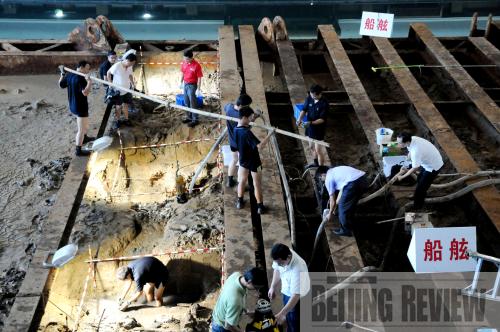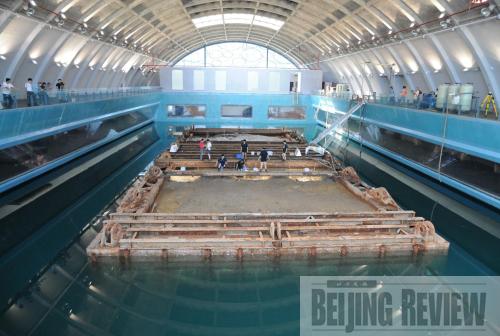|
 |
|
PORCELAIN RELICS: During the recent excavation of relics from the 800-year-old shipwreck Nanhai No.1, 200 pieces of porcelain are unearthed from the silt (LI XIANGYANG) |
The first probing of the ancient merchant vessel Nanhai No.1 after the wreck was put into a museum pool of simulated seawater successfully recovered porcelain and stone artifacts from its cabin on September 27. Archaeologists said the more than 200 precious porcelain artifacts found on the 800-year-old ship were produced by some of China's best kilns operating at that time.
First discovered at the sea bottom 18 nautical miles off the coast in the South China Sea, known as Nanhai, in 1987, the 30-meter-long wrecked ship is believed by Chinese archaeologists to be one of the largest and best-preserved ancient vessels in the world. Archaeologists salvaged the wreck and its surrounding silt with an iron container and hoisted it from its watery grave in December 2007.
The container was dragged ashore to a museum that was built specifically to exhibit the ship in the coastal city of Yangjiang. The find was put into a pool that allows scientists to control the water temperature, pressure and other conditions to replicate the seafloor upon which the ship rested for centuries. The creative salvage operation attracted enormous media coverage and was praised as a significant archaeological expedition for China.
Apart from protecting the ship's body from decay, the museum was designed to also allow future visitors to admire the wreck when walking along an underwater corridor with glass walls in the 2,400-square-meter pool.
 |
|
REVEALING THE PAST: Workers unearthing artifacts from Nanhai No.1 mark different parts of the ship body over its encasing silt to ensure that they do not damage the ship's remains (LI XIANGYANG) |
Wei Jun, who leads the exploration project, said besides recovering artifacts, the three primary goals are to assess the viability of researching the ship when it is in the museum, to examine the find's preservation status in the container and to extract samples to formulate protection plans for future explorations.
Wei said Nanhai No.1 is in surprisingly good shape compared with sunken ships of the same era.
"The wood of the vessel's sides and cabin is still solid. The upper deck is yellow rather than black, which proves that it wasn't carbonized," Wei said.
He explained that the vessel's preservation is attributed to the thick and air-proof silt shrouding it, which kept the wreck in an oxygen-free environment.
While research on the wreck has helped scientists to understand the advancement of China's shipping industry during the Song Dynasty (960-1279) when Nanhai No.1 was built, findings of what was on board have also shed light on a marine trading route between China and the West.
A popular theory among Chinese historians is that Chinese coastal merchants had shipped porcelain, cloth, silk and probably grain seeds from southern Guangdong Province ports to India since the Han Dynasty (206 B.C.-220 A.D.) or even earlier. These Chinese goods were then sold to people in Egypt and Rome. This trading route has been named the Marine Silk Road, and dates back to before its better-known overland namesake. Many people have doubted the existence of such a route due to a lack of evidence. The discovery of Nanhai No.1 goes a long way toward proving the route's existence.
 |
|
PERMANENT HOME: The 800-year-old shipwreck of Nanhai No.1, covered in silt, sits in a museum pool after it was hoisted from the seafloor in December 2007 (LI XIANGYANG) |
Between 1987 and 2007, archaeologists recovered more than 4,000 gold, silver and porcelain artifacts, and about 6,000 copper coins from Nanhai No. 1 when the ship was still on the seabed. Experts had earlier estimated that the ship was loaded with as many as 60,000 individual relics.
During the most recent round of excavations, an ink-grinding stone decorated with a goblet and cockscomb flower pattern, which were popular in Arab countries at the time, captured the attention of archaeologists. Zhang Wanxing, Deputy Director of the Marine Silk Road Museum that houses Nanhai No.1, said the ink-grinding stone proves that the ship used to travel on the marine trade route.
The finding also seems to support archaeologists' earlier guesses that the vessel sunk on its way to Southeast Asia or the Middle East for trade. The findings suggest that the porcelain trade was already so developed when the ship sank that China was making products particularly suited to the tastes and dining habits of customers thousands of miles away.
Another large exploration of the wreck is scheduled to start next year, said Wei, and the whole project is expected to take at least 10 more years.
The museum, which is expected to become a research base for maritime archaeology, will open to the public this year. | 